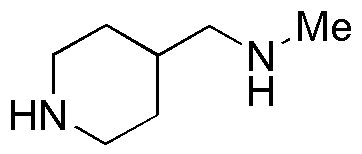Methyl-piperidin-4-ylmethylamine is widely utilized in research focused on:
- Pharmaceutical Development: This compound serves as a key intermediate in synthesizing various pharmaceuticals, particularly in the development of drugs targeting neurological disorders.
- Neurotransmitter Research: It plays a significant role in studying neurotransmitter systems, helping researchers understand mechanisms of action for certain medications.
- Material Science: Methyl-piperidin-4-ylmethylamine is used in creating advanced materials, including polymers and coatings that require specific chemical properties.
- Biochemical Assays: It is employed in biochemical assays to evaluate enzyme activities, providing insights into metabolic pathways and potential therapeutic targets.
- Chemical Synthesis: The compound is a valuable reagent in organic synthesis, offering advantages in reaction efficiency and selectivity compared to similar amines.
General Information
Properties
Safety and Regulations
Applications
Methyl-piperidin-4-ylmethylamine is widely utilized in research focused on:
- Pharmaceutical Development: This compound serves as a key intermediate in synthesizing various pharmaceuticals, particularly in the development of drugs targeting neurological disorders.
- Neurotransmitter Research: It plays a significant role in studying neurotransmitter systems, helping researchers understand mechanisms of action for certain medications.
- Material Science: Methyl-piperidin-4-ylmethylamine is used in creating advanced materials, including polymers and coatings that require specific chemical properties.
- Biochemical Assays: It is employed in biochemical assays to evaluate enzyme activities, providing insights into metabolic pathways and potential therapeutic targets.
- Chemical Synthesis: The compound is a valuable reagent in organic synthesis, offering advantages in reaction efficiency and selectivity compared to similar amines.
Documents
Safety Data Sheets (SDS)
The SDS provides comprehensive safety information on handling, storage, and disposal of the product.
Product Specification (PS)
The PS provides a comprehensive breakdown of the product’s properties, including chemical composition, physical state, purity, and storage requirements. It also details acceptable quality ranges and the product's intended applications.
Certificates of Analysis (COA)
Search for Certificates of Analysis (COA) by entering the products Lot Number. Lot and Batch Numbers can be found on a product’s label following the words ‘Lot’ or ‘Batch’.
*Catalog Number
*Lot Number
Certificates Of Origin (COO)
This COO confirms the country where the product was manufactured, and also details the materials and components used in it and whether it is derived from natural, synthetic, or other specific sources. This certificate may be required for customs, trade, and regulatory compliance.
*Catalog Number
*Lot Number
Safety Data Sheets (SDS)
The SDS provides comprehensive safety information on handling, storage, and disposal of the product.
DownloadProduct Specification (PS)
The PS provides a comprehensive breakdown of the product’s properties, including chemical composition, physical state, purity, and storage requirements. It also details acceptable quality ranges and the product's intended applications.
DownloadCertificates of Analysis (COA)
Search for Certificates of Analysis (COA) by entering the products Lot Number. Lot and Batch Numbers can be found on a product’s label following the words ‘Lot’ or ‘Batch’.
*Catalog Number
*Lot Number
Certificates Of Origin (COO)
This COO confirms the country where the product was manufactured, and also details the materials and components used in it and whether it is derived from natural, synthetic, or other specific sources. This certificate may be required for customs, trade, and regulatory compliance.

